Excerpts from Jim Conrad's
Naturalist Newsletter
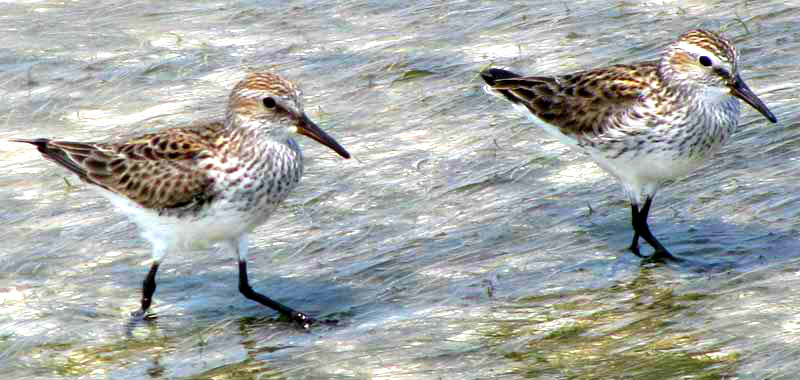
from the the May 22, 2011 Newsletter issued from written at Mayan Beach Garden Inn 20 kms north of Mahahual, Quintana Roo, México
TARRYING SANDPIPERS
Here in mid May little flocks of Western Sandpipers, CALIDRIS MAURI, still work up and down the beach probing their black beaks into sand and wads of wind-heaped-up seaweed. Two such birds are seen above.
Western Sandpipers are listed as winter visitors in this part of the world, so shouldn't they be on their way to their nesting grounds in western coastal Alaska? And why haven't the birds in the picture acquired the rusty backs of their summer plumage?
Their being here so late makes sense because at this time of year western Alaska still is a bit wintry. It's an accepted ecological rule that chick growth in high-latitude breeding shorebirds is very fast. By the way, a study in Alaska found that on the average Western Sandpiper nests fledged only 1.7 chicks.
In A Guide to The Birds of Mexico and Northern Central America, Howell writes that rarely Western Sandpipers summer locally along both Mexican coasts. I wonder if maybe those rare birds remaining here all summer might represent the species testing the strategy of just not making that long trip North in the first place. Or maybe they're just too young, too old or too sick to make the flight.
from the August 16, 2009 Newsletter, reporting on a visit to Lost Creek Lake in Jackson County, southwestern Oregon:
PEEPS AT THE WATER'S EDGE
I heard a familiar sharp peeping call from down at the water's edge. It was one of the "peeps," which are any of a number of smallish, sharp-billed, long-legged little bird species frequenting shores of large bodies of water. But, which peep was it? That's them below:
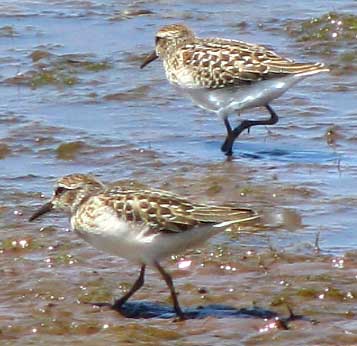
I had problems figuring out this bird. Especially because so much pure white outlined the otherwise brown feathers I thought it was a migrating Sanderling, for it looks like what's in my old Peterson fieldguide.
However, my friend Romain doubted it, opting instead for a Western Sandpiper, CALIDRIS MAURI," shown in my Peterson as having tan fringes to the brown feathers, not white ones.
"Believe that a sanderling juvie would not have as "heavy" and slightly dropped beak like westerns do," Romain said. "Migrating westerns would be more expected (seasonally common in small numbers) on Lost Creek Reservoir. Sanderlings are less so though probably annually detected or detected a few times annually."
Romain wasn't sure himself, though, so he sent the picture to Greg, an expert:
"The bold feathers of the upper wing, with black "anchor" marks, crisp white tips, and bright centers indicate these are juveniles in fresh plumage. The adults already migrated through, with their very worn and faded plumage that they received new in early spring, migrated to the Arctic, bred, and migrated back. The strong white eyebrow, droop-tipped bill, and rufous tones to crown and scapulars clinch the ID as Western Sandpipers. One other thing. The rear bird with its foot lifted? See the tiny hind toe? Sanderlings lack hind toes completely."
Good grief. Wandering peeps after the breeding season sure are hard to ID, but apparently it can be done if you're sharp enough.
from the September 18, 2011 Newsletter issued from Mayan Beach Garden Inn 20 kms north of Mahahual, Quintana Roo, México
SEMIPALMATED & WESTERN SANDPIPERS
The rest of the flock at the little wave-pool consisted of Semipalmated Sandpipers (CALIDRIS PUSILLA) and Western Sandpipers (CALIDRIS MAURI), seen above.below:
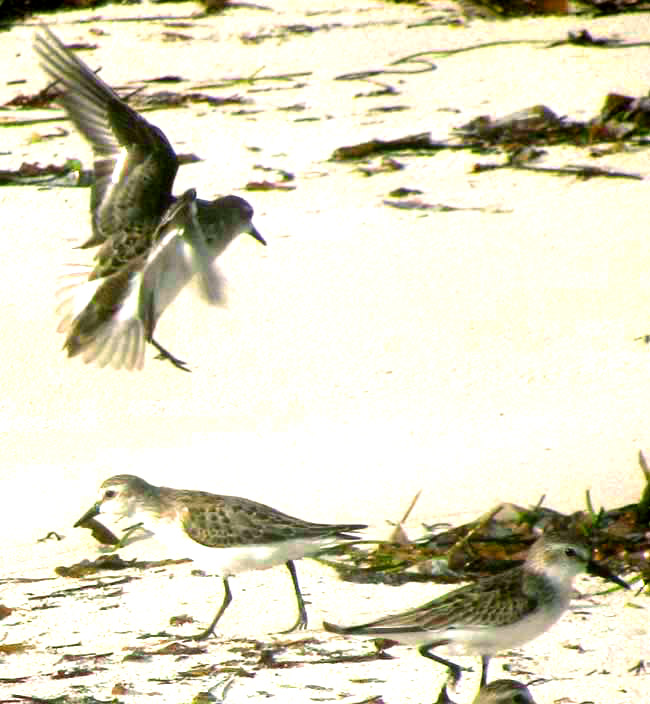
The flying bird in that picture, with its white wing stripes and dark rump feathers extending into the tail's center distinguish the Semipalmated and Western Sandpipers from other sandpiper species, but not from one another. In fact, it took me awhile to realize that in the picture the walking bird at the bottom left could be a different species from the one walking on the right. I thought I knew which was which, but I was so insecure about it that before naming them here I wrote to my friend David, master birder in Bermuda and absolute genius for oceanic and coastal species. He replied:
"...the left sandpiper on the ground is a classic adult Semipalmated and the right one on the ground is a classic juvenile Western."
David further explained that Westerns usually exhibit slightly downcurved bills with thickened bases, though many Semipalmated bills are nearly as long. He says that the clincher is to look for the Western's slightly larger body size, and in immature plumage the rusty reddish coverts at the shoulder. Adult Westerns usually show bolder streaking or speckling along their sides. He further points out that adults can be distinguished from immatures because adults have uneven, black blotches on wing coverts and backs. Immatures are always uniformly scalloped with buffy edges to their feathers.
Semipalmated Sandpipers, which my beat-up, 1966-issue of Robbins' Birds of North America describes as "probably the most abundant shorebird," occur here on the Yucatán Peninsula's eastern shore only during spring and fall migrations, though some overwinter on the peninsula's northern coast. The species winters from southern Mexico and the Caribbean to Chile and Argentina.
Western Sandpipers, in contrast, overwinter throughout most of Mexico, including all of coastal Yucatán. They winter from the southern US into northern South America.
from the September 18, 2011 Newsletter issued from Mayan Beach Garden Inn 20 kms north of Mahahual, Quintana Roo, México
PREENING
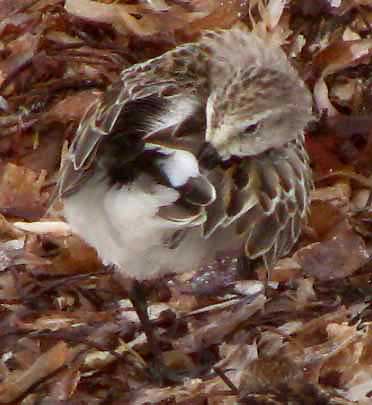
David also confirmed as a Western Sandpiper the bird shown above, at the right in the picture, poking his long beak into his tail area. That bird is beginning a period of preening by daubing his long beak onto his preen gland, or uropygial gland. The preen gland is a fleshy, small, oil producing, nipplelike nubbin typically at the base of a bird's back, about where shorter, fluffier back feathers yield to longer, stiffer tail feathers. During preening, birds smear oil from the gland onto their beaks or heads, then rub their beaks or heads over their bodies' feathers, oiling them up. The above sandpiper can be seen applying oil to his feathers below:
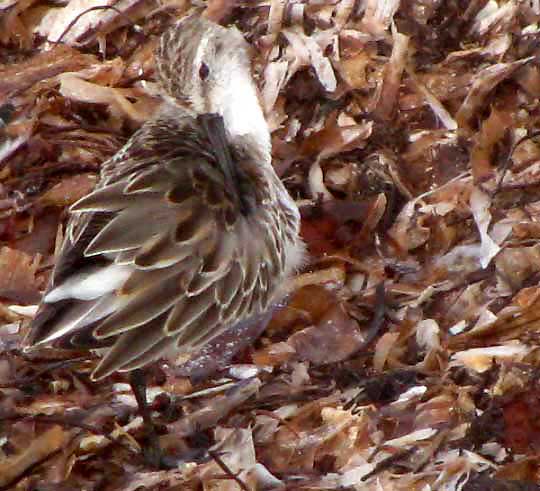
The oil helps waterproof feathers and may be important in controlling the bird's external parasites. The vast majority of birds have preen glands; emus, kiwis, ostriches, and bustards don't.